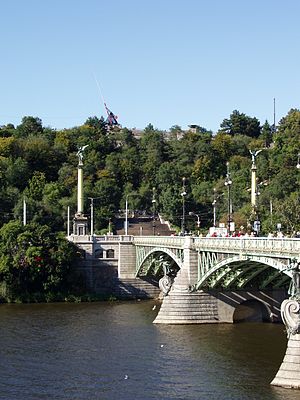Letná
| Letná | ||
|---|---|---|
|
Letná height from the south, Čechův most in the foreground |
||
| height | 265 m nm | |
| location | Czech Republic | |
| Coordinates | 50 ° 5 '58 " N , 14 ° 25' 15" E | |
|
|
||
Letná (formerly known as Sommerberg or Belvedere ) is the field name of a Prague hill north of the city center and often the abbreviation for an elevated plain called Letenská pláň (Letná plain) and adjoining Letenské sady ( Letná Park ). The Letná height lies in the Prague cadastral parishes of Bubeneč and Holešovice . Despite its location close to the center, this area is largely still an open space with changing uses and is a popular local recreation area.
location
Letná is an area of Prague northwest of the city center in the Prague 7 district , centered on one of the seven surrounding hills . The southern half of Letná belongs to the Prague cadastral municipality (katastrální území) or the Holešovice district and the northern half to the Bubeneč district , with Ul. Milady Horákové ( Milada Horáková Street) represents the dividing line. The Malá Strana (Lesser Town) and Hradčany are the adjacent districts in the southwest and west, while the Stromovka Park borders the Letná from the north. The Vltava River separates the Letná from Prague's Old Town (Pražské Staré Město) in the north and Prague's New Town (Pražské Nové Město) in the south.
The park
The Letna Park ( Letenské sady ) is adjacent to the Chotek Park , which is part of the Royal Gardens of Prague Castle is. Today it is connected to Chotek Park by a footbridge over Chotkova Silnice Street .
In the park is located since 1898 as a garden restaurant in the historicist Hanavský pavilion of the Prague Jubilee Exhibition in 1891 and the former Panorama restaurant Praha Expo 58 , which was originally on the Expo 58 in Brussels was.
Despite its location close to the center, Letná Park is still a popular local recreation area for the Prague population.
The meeting place
From 1955 to 1962 the Stalin monument stood on Letná Heights . The communist mass gatherings on May Day and military parades of the Czechoslovak People's Army were held in the large open area adjacent to the gardens until 1989 .
During the Velvet Revolution on November 25 and 26, 1989, demonstrations took place on the Letná Plateau in the run-up to the general strike on November 27, in which more than half a million people took part.
On the spot where the Stalin memorial stood from 1955 to 1962, a giant metronome was set up in 1991 as a symbol of the changing times , created by the sculptor Vratislav Karel Novák (1942-2014). Large pop concerts were later held here (such as the first concert on Michael Jackson's 1996 European tour). Pope John Paul II celebrated a field mass here on the occasion of his pastoral visit in 1990.
The football stadium of AC Sparta Praha named Generali Arena , also known as Letna Stadium and Sparta Stadium is also located here in this area.
Traffic history
Since July 18, 1891, the area has been accessed by the Letná funicular ( Lanová dráha na Letnou or Lanovka na Letnou for short ) from the old town on the western bank of the Vltava . This funicular was owned by the city of Prague from the start, but was shut down again in 1916 as a result of the lack of energy during the First World War and was declared permanently shut down in 1922. A few years later, the railway was largely dismantled and a large escalator was built on its route , which was still in operation until August 27, 1935. After that, all systems on the site were finally dismantled. Some remains can still be seen today, especially at the former mountain station.
The upper terminus of the Letná tram built by František Křižík ( Elektrická dráha na Letné v Praze or, for short, Letenská elektrická dráha ) was located directly opposite the mountain station of the funicular . It was the first electric tram in Prague and at the same time the first ever built Czech electric tram. It was opened with the Letná funicular and the Petřín funicular as part of the Great Prague Jubilee Exhibition in 1891 on the same July 18, 1891, and in 1897 it was sold to the newly established municipal transport company. The tram ran until the late summer of 1900, when it was discontinued and its lower section was integrated into the new urban tram network, while its upper section was dismantled down to the Letná Heights.
In the years 1949–1951, the Letná tunnel with a length of 426 m was built to replace the previous public transport system leading up the hill and to better connect the city center of Prague with the Letná and Dejvice districts . In September 2015 the Blanka tunnel complex was put into operation, to which there is an access north of the Letná height.
Currently open questions
For the large open space ( Letenská pláň ) there are always various suggestions for use. The focus of the debate is currently on the project of a new national library by the Czech architect Jan Kaplický , a hotly debated example of blob architecture . Earlier proposals included a new large football stadium or an aquarium .
Web links
- History and information about Letná (Czech) ( Memento from February 28, 2008 in the Internet Archive )





